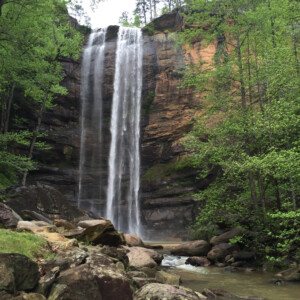Forests & Water: A Critical Combination
By Scott Thackston, GFC Water Quality Program Coordinator
At the Georgia Forestry Commission, we’re proud to share the countless benefits that forests supply. Not only do they provide essential products like lumber and paper, but forestland itself is a resource with a long list of attributes. Wildlife habitat, recreation and aesthetics, carbon storage, and clean air are just a few. Thousands of forest-related jobs benefit families, communities, and the state’s economy. Best of all, forests are a renewable resource – if we protect them.
Forests thrive hand in hand with another valuable resource: water. Water is what makes earth a “living planet,” and all living things, including humans, must have it to live. We’re accustomed to expecting clean water will be there for us – whenever and wherever we want.
 Did you know that affordable clean water wouldn’t come out of our faucets without forests? Forests filter rain water as it soaks into the earth and drains into aquifers, streams, and rivers. Contiguous forestlands that supply clean water can make water treatment operations more efficient and less expensive.
Did you know that affordable clean water wouldn’t come out of our faucets without forests? Forests filter rain water as it soaks into the earth and drains into aquifers, streams, and rivers. Contiguous forestlands that supply clean water can make water treatment operations more efficient and less expensive.
But what if that forest above ground is disturbed? “Up top headwaters” impact the entire filtration process. Urban and suburban sprawl is removing swaths of land in Georgia. Unchecked land conversion to commercial and residential development, solar farms, or pasture and cropland impacts forests’ filtration effectiveness.
You may not know that the GFC has a team whose main focus is protecting the quality of Georgia’s waterways. Since 1991, GFC has had a contract with the GA Environmental Protection Division to provide advice, education, and monitoring data concerning forestry operations, water, and systems that protect our waterways. Those systems are known as Best Management Practices, or BMP’s. The GFC monitors forestry activities to deliver a statewide BMP Survey biennially. These common-sense, science-based and practical guidelines are supported by the forestry community, and they’re working – extraordinarily well.
In simple terms, the BMP Survey is a “report card” on how well forestry operations are protecting water resources, and in 2023, the forestry community got all A’s! The survey covered 266 randomly selected sites statewide, consisting of 56,477+ acres. Those acres included 269 miles of forest roads, 130 miles of streams, and 150 stream crossings. The 2023 BMP Survey shows implementation at 96.8%, which is a new high score and reflects a 4.23 percentage point improvement from the 2021 survey.
The BMP survey measures risks to water quality as well, which include areas such as harvesting, mechanical site prep and firebreaks/burning. Those areas, along with all other survey categories, earned 90% or above implementation ratings. All risks and all practices are addressed in regular education outreach, so forest industry personnel can stay abreast of state progress and methods for improvement. The GFC has strong partnerships with several organizations to make these sessions available, including the Sustainable Forestry Initiative, University of Georgia, Southeastern Wood Producers Association, GA Forestry Association, the forest industry and of course, forest landowners.
As you might imagine, it takes a lot of hours and a lot of assessments to come up with the data for such an important report. We’re really proud of that, too! So if you’re interested in what it takes for the Georgia forestry family to protect our precious water resources, we invite you to check out the full 53-page report. Spoiler alert: it’s an excellent story with a great conclusion!
[FULL] https://gatrees.org/wp-content/uploads/2023/12/2023_BMP_Survey_Results_Report_Final_V1.pdf.
[HIGHLIGHTS] https://gatrees.org/wp-content/uploads/2023/12/2023_Forestry_BMP_Survey_Highlights_WEBSITE-FINAL-121323.pdf.
